Biology The Study of Life: Part 22 (What Are Species and How Do New Ones Arise?)
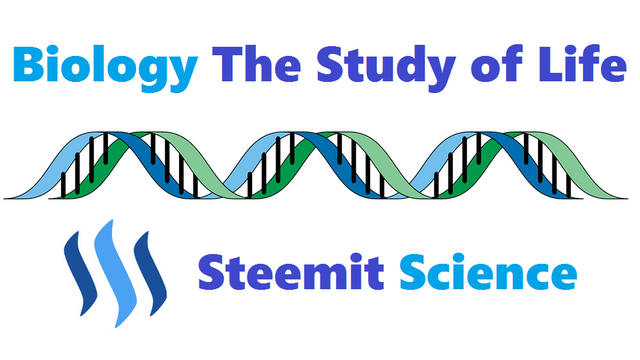
Introduction
This informative series of posts will explore modern biology; the fundamental principles of how living systems work. This material will always be presented at the level of a first-year college biology course, without assuming any prior background in biology or science. It also presents material in a conceptual format. Emphasizing the importance of broad, unifying principles, facts and details in the context of developing an overarching framework. Finally, the series takes a historical approach wherever possible. Explaining how key experiments and observations led to our current state of knowledge and introducing many of the people responsible for creating the modern science of biology.
What is meant by a species?
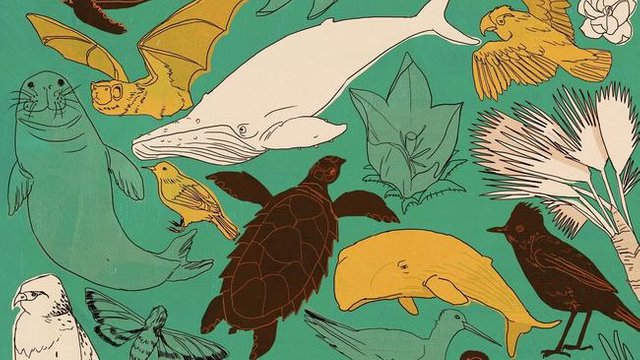
The biological species concept, which defines species on the basis of reproductive isolation, is used most commonly by biologists in spite of its theoretical and practical difficulties. Alternative definitions are introduced, with a discussion of the advantages and disadvantages of each. The lecture then turns to the question of how new species arise. Allopatric speciation represents the most straightforward case, in which an ancestor species becomes divided by a physical barrier into two separate populations that are prevented from exchanging genetic material.
The dominant view of contemporary biologists is descent with modification.
This suggests that all living and extinct species descended from a common ancestral species that lived more than 3 billion years ago. If this is true, evolutionary mechanisms must have somehow led to the creation of new, distinct species (speciation) and frequently, to account for the variety of living species. Though speciation is an established fact, its mechanisms are not fully understood, and it remains an active area of research.
Organisms often appear to fall into distinct groupings.
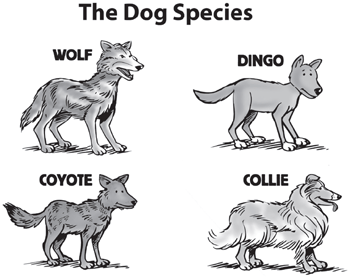
We intuitively think of these groupings as species (from the Latin meaning “kind” or “type”) representing well-defined categories of living things. The problem of defining and classifying species, however, is not as easy as it first appears. A single species might occur in distinct forms a Chihuahua and a German shepherd, for example. Different species may be virtually indistinguishable from each other, as with willow and alder flycatchers. Evolutionary biologists are particularly interested in the problem of how new species arise. To address this question, we first must have some way of objectively defining a species.
The most commonly used framework for defining species is the biological species concept first articulated in 1942 by Ernst Mayr, one of the notable evolutionary biologists of the 20th century.
Mayr defined a species as a population or group of populations that can successfully interbreed in nature and produce viable and fertile offspring but cannot successfully interbreed with members of other species. Thus, the ability of two organisms to reproduce sexually provides the foundation of the biological species concept. An equivalent way to say this is that a biological species is the most inclusive grouping of organisms for which the exchange of genetic information is possible. By this concept, barriers to the exchange of genetic information separate species—this is called reproductive isolation.
The biological species concept is generally accepted in practice, but it does not account for some important cases.
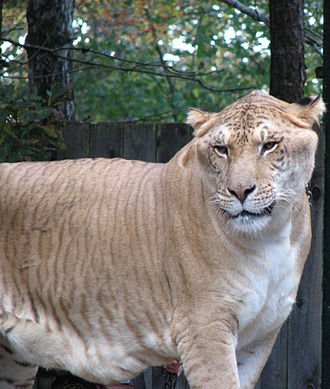
- Many otherwise distinct species sometimes hybridize and produce viable, fertile young in geographic regions where they overlap.
- Many groups of organisms reproduce sexually only infrequently or not at all. In these groups, the biological species concept simply cannot be applied.
- Paleontologists interested in extinct species known only from fossils obviously cannot use information about successful interbreeding to define species.
There are several alternatives to Mayr’s biological species concept.
The morphospecies concept is an older idea that emphasizes differences in physical characteristics alone. It is based on the assumption that physical differences are generally the result of genetic differences arising from genetic information. It is widely used by paleontologists because they have no other way to identify fossil species, but it suffers from subjectivity in the choice of relevant characteristics used to distinguish species.
The phylogenetic species concept is a recent idea that emphasizes the use of modern statistical tools to determine patterns of shared ancestry among a group of organisms, then defines species on the basis of these evolutionary patterns.
Both concepts can be applied to any group of organisms, living or extinct, but assumptions behind the morphospecies concept may not apply, while scientists typically do not have the data they need to use the phylogenetic concept fully.
In practice, biologists use a combination of different approaches, depending on which group they are working with, the questions to be answered, and the information available.
Having defined what we mean by species, we can now turn to the more difficult problem of understanding how new species have arisen over evolutionary time.
On examining the fossil record, we see two different patterns of speciation. Evolutionary forces acting on a species over evolutionary time may so transform that species that we would classify the living form as a distinct species compared to fossil forms. This sort of evolutionary transformation is called anagenesis and is presumably caused by natural selection, genetic drift, or other factors leading to cumulative changes. Alternatively, one ancestor species may give rise to two or more descendent species through the process of cladogenesis, or branching evolution. Cladogenesis must be responsible for the enormous diversity of species observed on the planet.
Given the strong bimodal distribution of the black-bellied seed-cracker, a reasonable question is whether it comprises one species or two.
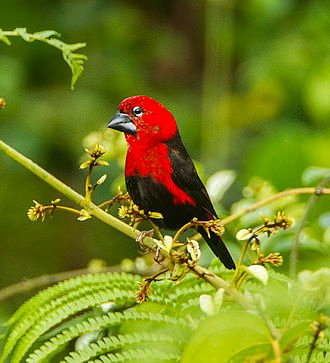
The black-bellied seed-cracker is considered one species because large-beaked and small-beaked birds mate and produce viable offspring. Furthermore, birds with intermediate beaks are born; they just do not survive as well as the others. The large-beaked and small-beaked birds could diverge into two species only if they stopped mating with each other. As long as the exchange of genetic material is possible, the birds remain a single species. The seed-cracker example illustrates the essential requirement for speciation: that gene pools become isolated from each other. Once this happens, the isolated gene pools will develop along divergent lines through natural selection.
There are thought to be two main sets of conditions under which gene flow can stop and gene pools become isolated. These conditions correspond to two modes of speciation.
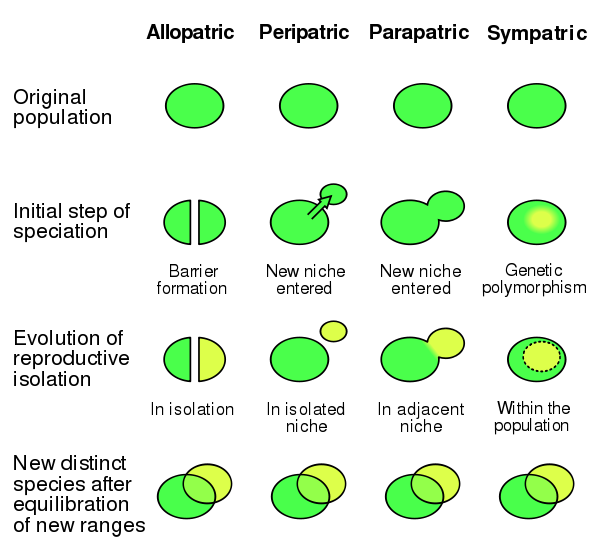
- Allopatric speciation involves the physical division of a gene pool by a barrier, such as a geographic feature.
- Sympatric speciation involves the division of a gene pool without physical or geographic separation.
It is harder to envision this happening, and some biologists have been skeptical that it occurs at all.
Most work on speciation has focused on allopatric speciation, which is conceptually straightforward and relatively easy to illustrate.
To understand allopatric speciation, first consider a population of a single species that has a relatively broad geographic distribution, such as a plant species spread across a plain. Now, imagine that two subpopulations become separated by a geographic barrier, such as a rise in sea level. The plants could then live only on the separated highlands. Other geological events, such as the upthrusting of a mountain range, the movement of a glacier, or even continental drift, could also divide a population. When a physical barrier divides a geographically continuous population, it is called a vicariance event and the new, disjunct distribution is called a vicariance distribution.
Allopatric speciation can also occur when a subpopulation moves across a physical barrier and becomes isolated.
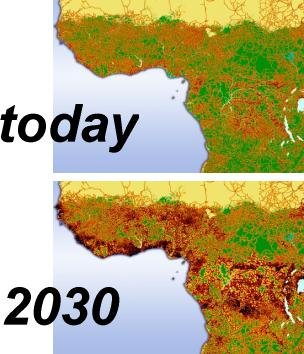
This is called a dispersal event, with a resulting dispersal distribution. Darwin’s finches are an example of serial colonizations of each Galapagos island. Once subpopulations become separated by a physical barrier, their new environments are usually at least slightly different. Natural selection will, therefore, cause the gene pools of isolated subpopulations to change over time. Depending on the size of the subpopulations, genetic drift can play a large role in evolutionary change. It tends to be a large factor in dispersal events, for example. The isolated gene pools may diverge to the point that the subpopulations can no longer mate successfully, even after the physical barrier is removed. At this point, we would consider the two subpopulations to have become distinct species.
END PART 22
BIOLOGY THE STUDY OF LIFE:
PART 1 INTRODUCTION
PART 2 WHAT IS LIFE
PART 3 ORIGIN OF LIFE
PART 4 CELL TO ORGANISM
PART 5 PROTEINS
PART 6 CODE OF LIFE
PART 7 DOUBLE HELIX
PART 8 REPLICATING DNA
PART 9 CENTRAL DOGMA
PART 10 GENETIC CODE
PART 11 DNA TO RNA
PART 12 RNA TO PROTEINS
PART 13 MISTAKES HAPPEN
PART 14 WHEN CELLS DIVIDE
PART 15 MENDEL'S PEA PLANTS
PART 16 SEX AND VARIATION
PART 17 GENES AND CHROMOSOMES
PART 18 CHARLES DARWIN ON THE ORIGIN OF SPECIES
PART 19 NATURAL SELECTION
PART 20 DARWIN VS MENDEL
PART 21 MECHANICS OF EVOLUTIONARY CHANGE
PART 22 MECHANICS OF EVOLUTIONARY CHANGE
Image Credits -
http://www.trbimg.com/img-55bc1ea6/turbine/la-oe-0802-moore-hawaii-endangered-species-201-001/650/650x366
https://cdn-assets.answersingenesis.org/img/articles/nab3/dog-species.gif
https://upload.wikimedia.org/wikipedia/commons/thumb/4/4e/Liger.jpg/330px-Liger.jpg
https://upload.wikimedia.org/wikipedia/commons/thumb/b/bb/Black-bellied_Seedcracker_-_Kakum_-_Ghana_S4E2847_%2822799387200%29.jpg/330px-Black-bellied_Seedcracker_-_Kakum_-_Ghana_S4E2847_%2822799387200%29.jpg
https://upload.wikimedia.org/wikipedia/commons/thumb/5/53/Speciation_modes.svg/600px-Speciation_modes.svg.png
https://upload.wikimedia.org/wikipedia/commons/2/2b/Grasp_africa.jpg
Bird [Giphy](https://giphy.com/gifs/blue-5lDik5jPpRw2Y)

 or
or  @pjheinz
@pjheinz

Everyone knows all species were created by the Flying Spaghetti Monster one day 6,000 years ago!